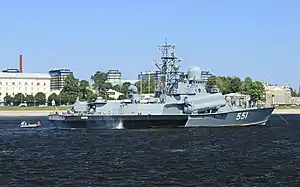Russian corvette Livien'
Livien' is a Nanuchka-class corvette in the Russian Navy.
 Livien' in Saint Petersburg, 2018 | |
| History | |
|---|---|
| Name |
|
| Namesake | Livien' |
| Builder | Almaz Shipyard, Leningrad |
| Yard number | 83 |
| Laid down | 29 September 1988 |
| Launched | 8 May 1991 |
| Commissioned | 25 October 1991 |
| Identification | See Pennant numbers |
| Status | Active |
| General characteristics | |
| Class and type | Nanuchka III-class corvette |
| Displacement |
|
| Length | 59.3 m (194 ft 7 in) |
| Beam | 12.6 m (41 ft 4 in) |
| Draft | 2.7 m (8 ft 10 in) |
| Propulsion |
|
| Speed | 32 knots (59 km/h) |
| Range |
|
| Complement | 60 |
| Sensors and processing systems |
|
| Armament | |
Specifications
Small missile ships of the Project 1234 according to NATO classification Nanuchka-class corvette is a series of Soviet small missile ships (MRK) of the 3rd rank built at shipyards of the USSR from 1967 to 1992.[1]
The type consists of three series of subprojects:
- Project 1234, NATO code Nanuchka I
- Project 1234E, NATO code Nanuchka II
- Project 1234.1, NATO code Nanuchka III
- Project 1234.7, NATO code Nanuchka IV
By the name of the project code, the ships received the nickname gadflies in the navy. IRAs of Project 1234 were supplied to the Navy of four countries of the world: the USSR, Algeria, Libya and India. Libyan ones were destroyed during the NATO military operation in the summer of 2011; Indian ships of this project were withdrawn from the Indian Navy in 1999–2004.
The ships of the project were actively operated in all four fleets of the Soviet Navy and during the 1970-1980s carried out combat services in the World Ocean. They left a noticeable mark on the history of Soviet shipbuilding and are currently being gradually withdrawn from the combat strength of the Russian fleet.[1] So, if at the beginning of 2001 in the Russian Navy there were 2 ships of project 1234 and 18 ships of Project 1234.1,[2] then by 2006 all ships of project 1234 were withdrawn from the Navy and only 12 ships of the project remained in Project 1234.1 and 1 ship of Project 1234.7.[3][4]
Construction and career
Livien' was laid down on 29 September 1988 at Almaz Shipyard, Leningrad. Launched on 8 May 1991 and commissioned into the Baltic Fleet on 25 October 1991.[5]
Pennant numbers
| Date | Pennant number[5] |
|---|---|
| 1991 | 475 |
| 1991 | 551 |
Citations
- Kostrichenko, V. V.; Kuzmichev, V. E. Пистолет у виска империализма. p. 2.
- Yu.V., Apalkov (2004). Корабли ВМФ СССР. Справочник. Галея Принт. p. 11. ISBN 5-8172-0087-2.
- "Атрина". www.webcitation.org. Archived from the original on 5 October 2008. Retrieved 20 September 2021.
- "Сайт «АТРИНА» • Малый ракетный корабль пр.12347; Nanuchka-IV class". 13 March 2012. Archived from the original on 13 March 2012. Retrieved 20 September 2021.
- "Small Missile Ships - Project 1234". russianships.info. Retrieved 20 September 2021.